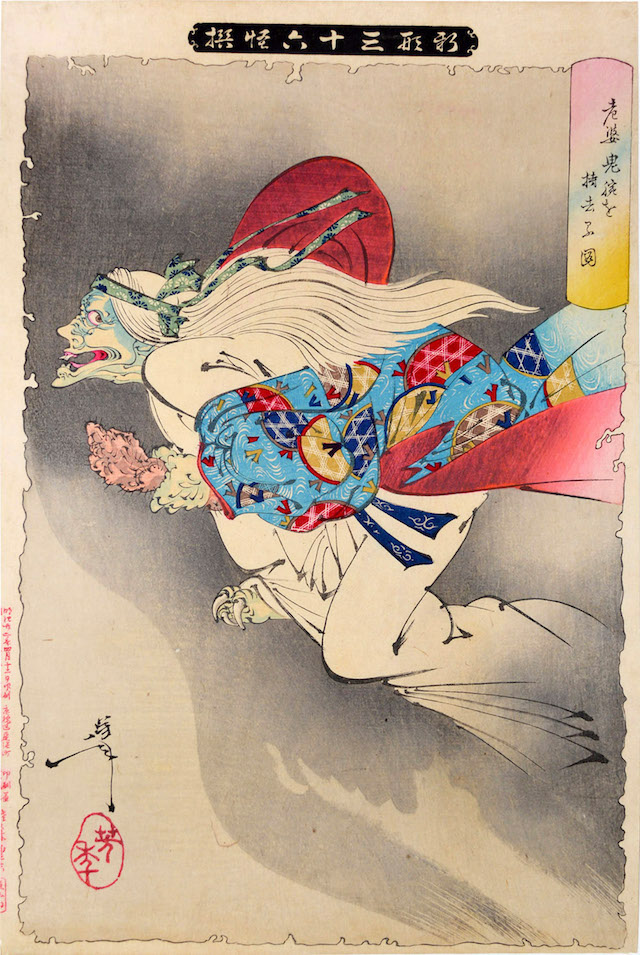When American warships appeared off the coast of Japan in 1853, it marked the country’s forced entry into a changing, increasingly global world. It was also the year that a young printmaker named Tsukioka Yoshitoshi would publish his first work. Gunboat diplomacy, which introduced Japan to Western culture, brought with it new materials and inspiration for artists. But it was also an era of violent upheaval in a long-secluded country. Yoshitoshi’s ukiyo-e prints created during this time reflect this push and pull of identity, tradition, and technology.
At the height of his success, Yoshitoshi created 100 Views of the Moon. The series of 100 prints, currently on view for a final week at Ronin Gallery in New York, was produced over the course of several years. It is considered a mastery of the new techniques and materials introduced to Japanese artists at the time. The prints bridge traditional and contemporary techniques and themes, depicting scenes of Eastern folklore and history, while introducing the use of chemical dyes, contemporary composition styles, and bold details. To modern viewers, the line work, text boxes, and action scenes in the images might resemble comic books.
Videos by VICE
Ukiyo-e prints remain a global symbol of visual culture in Japan to this day. The ever-popular image of a cresting wave with Mount Fuji in the distance is an ukiyo-e print. Woodblock printing in Japan originated as early as 1640, and the first full-color prints appeared in 1765. “Ukiyo-e” literally translates to “pictures of the floating world,” and the images often depicted concubines, actors, and scenery found in Japan’s pleasure districts.
Prints came in a variety of sizes and were collaborative in nature. A single image originated with a designer, responsible for drawing a sketch and dictating print colors. Then, an engraver carved a series of cherry wood blocks, cutting a different stamp for each ink color. Next, a printer went to work, composing the final image with exacting detail. Many preliminary sketches and stamps were lost to history, and much of what was preserved was destroyed in The Great Japan Earthquake of 1923. For all the labor involved, ukiyo-e prints were surprisingly affordable for ordinary Japanese citizens. Many cost as little as the price of a lunch.
“As the printed vehicle of popular culture, the longevity of a print depended on the popularity of its subject,” David Taro Libertson, the current owner of Ronin Gallery, tells The Creators Project. “With such quick turnaround, woodblock prints were ephemera in their original context, enjoyed and collected, but affordable and sensitive to cultural tides.”
Yoshitoshi’s work is particularly notable because it was created during a tumultuous time in Japanese history. According to the Ronin Gallery catalogue, “he made sense of a transitioning world with a familiar medium. His work expresses the pervasive atmosphere of uncertainty that plagued [Japan] and exorcises the demons of social and political upheaval.” Yoshitoshi prints from the late 1860’s are filled with death and brutality, reflecting the violence that plagued Japan at the time. He also spearheaded the use of chemical aniline dyes, which introduced vibrant reds and deep purples to Japanese printmaking, in contrast to traditional plant and mineral-based dyes, which rendered subtler shades.
Yoshitoshi struggled with personal demons throughout his life, and in the early 1870s, succumbed to mental illness and sank into poverty. Though his fortunes rebounded long enough to meet publisher Akiyama Buemon in 1885 and produce 100 Views of the Moon, by the early 1890s he was in and out of psychiatric institutions before succumbing to a cerebral hemorrhage in 1892 at the age of 53.
His body of work marks the last great ukiyo-e images. After Yoshitoshi’s death, woodblock printing branched off into Sosaku Hanga, or “creative prints,” and Shin Hanga, or “new prints,” categories that marked the birth of contemporary Japanese printmaking. He was a prescient artist, however, and his work is treasured to this day for melding ancient techniques with modern sensibilities.
Yoshitoshi’s work is currently on view at Ronin Gallery through Oct. 22.
Related:
How a Japanese Printmaker Influenced ‘Kubo,’ the Biggest Stop-Motion Film Ever
Miyazaki Meets Warhol in Reimagined Soup Can Series
The Master Of Coded Language And Deceiving Text Gets A Retrospective


